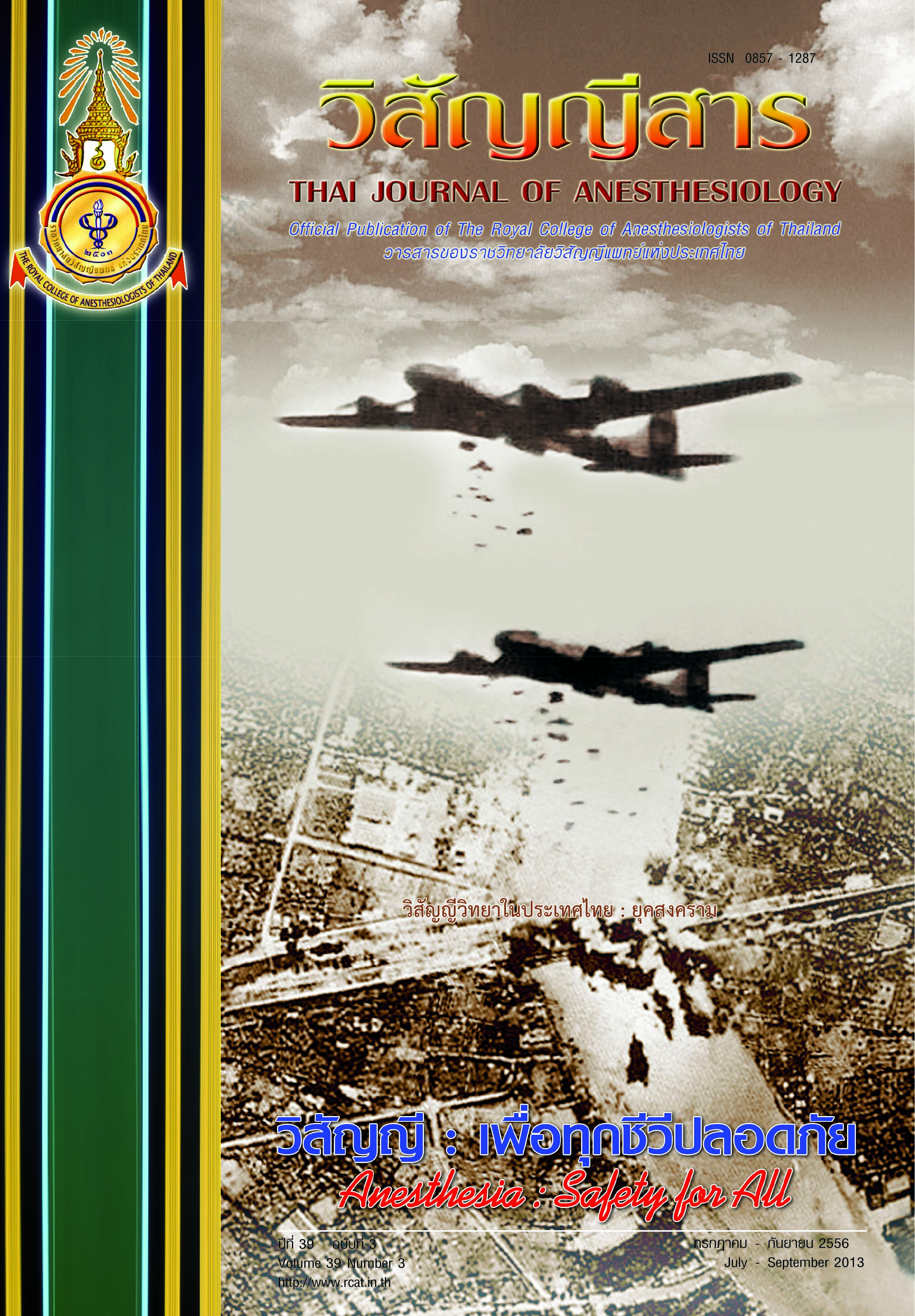Risk factors of peri - operative hypothermia in adult patients managed with standard prophylaxis: a case - control study
Main Article Content
Abstract
Background: Peri - operative hypothermia causes many serious complications, such as coagulopathy, myocardial ischemia, cardiac arrhythmias, delayed awakening, and wound infection. Although prophylaxis guideline has been implemented to every patient in Srinagarind hospital, hypothermia still occurs.
Objectives: To identify prevalence and risk factors of peri - operative hypothermia in patients having standard prophylaxis.
Methods: This was a retrospective case-control study. All patients aged more than 12 years undergoing regional, general or combined anesthesia at Srinagarind hospital during October 2009 and September 2010. were reviewed. They were managed with standard guideline for hypothermia prophylaxis. Hypothermia was defined as core temperature below 35 degree Celsius. One hundred eighty three hypothermic patients were identified and labeled as case. One hundred fifty four patients were enrolled as control. The following risk factors were extracted: age, weight, height, operation time, type of operation, intravenous fluid intake, units of packed red cell and fresh frozen plasma infused, blood loss, and irrigation fluid volume. All risk factors were analyzed by univariate and multivariate analysis for crude and adjusted odds ratios.
Results: From total 12,053 patients, there were 183 hypothermic patients. The prevalence was 1.52%. The hypothermic group had higher age, lower weight, and comparable height. The operation time, endoscopic or laparoscopic surgery, intravenous fluid intake, packed red cell and fresh frozen plasma transfused, blood loss, and irrigation fluid volume were higher in the hypothermic group. From univariate analysis, the crude odds ratios of operation time > 180 min, endoscopic or laparoscopic surgery, intravenous fluid intake > 2 liters, blood loss > 1 liter and irrigation fluid > 10 liters were 1.773, 2.250, 2.600, 3.859 and 17.200, respectively. From multivariate analysis, only three risk factors, i.e., endoscopic or laparoscopic surgery, blood loss > 1 liter, and irrigation fluid > 10 liters, were in the equation with adjusted odds ratios of 2.434, 4.238, and 17.304, respectively.
Conclusion: With standard prophylaxis, intra-operative hypothermia still occurred with prevalence of 1.52%. The risk factors from multivariate analysis were endoscopic or laparoscopic surgery, blood loss more than 1 liter, and irrigation fluid more than 10 liters. Irrigation fluid more than 10 liters had the greatest influence with adjusted odds ratios of 17.304. Warming of irrigation fluid was suggested.
ปัจจัยที่มีผลต่อภาวะอุณหภูมิกายตํ่าขณะผ่าตัดใน ผู้ป่วยผู้ใหญ่ที่ได้รับการป้องกันตามมาตรฐาน: ศึกษา แบบ case – control
บทนำ : ภาวะอุณหภูมิกายตํ่าขณะผ่าตัดจะเพิ่มภาวะแทรกซ้อน เช่น ภาวะเลือดแข็งตัวยาก กล้ามเนื้อ หัวใจขาดเลือด หัวใจเต้นผิดจังหวะ ฟื้นตัวจากยาสลบช้า และ แผลผ่าตัดติดเชื้อ แม้จะให้การป้องกันโดยการใช้ เครื่องเป่าลมร้อนตามมาตรฐานของภาควิชาวิสัญญีวิทยา ก็ยังมีอุบัติการณ์เกิดขึ้น
วัตถุประสงค์: เพื่อวิเคราะห์หา อุบัติการณ์และปัจจัยเสี่ยงที่ทำให้เกิดภาวะอุณหภูมิกายต่ำ ขณะผ่าตัดในผู้ป่วยที่ได้รับการป้องกันตามมาตรฐาน
วิธีการศึกษา: เป็นการศึกษาย้อนหลังแบบ case - control study ศึกษาในผู้ป่วยที่อายุมากกว่า 12 ปีที่มารับการ ผ่าตัดที่โรงพยาบาลศรีนครินทร์ เก็บข้อมูลระหว่างเดือนตุลาคม 2552 ถึงเดือนกันยายน 2553 ผู้ป่วยทั้งหมดได้ รับการป้องกันภาวะอุณหภูมิกายต่ำ โดยใช้เครื่องเป่าลมร้อนตามมาตรฐาน ได้ผู้ป่วยที่มีภาวะอุณหภูมิกายตํ่า ซึ่ง ให้คำ จำกัดความว่าตํ่ากว่า 35 องศาเซลเซียส จำนวน 183 คนเป็นกลุ่มศึกษา และเก็บตัวอย่างผู้ป่วยอุณหภูมิกาย ปกติที่ได้รับการผ่าตัดคล้ายคลึงกันในช่วงเวลาใกล้เคียงกัน จำนวน 154 คนเป็นกลุ่มควบคุม เก็บข้อมูลระหว่าง ผ่าตัดดังต่อไปนี้ อายุ นํ้าหนัก ส่วนสูง ระยะเวลาผ่าตัด ชนิดการผ่าตัด สารนํ้า เลือดและส่วนประกอบของเลือด ที่ได้รับ ปริมาณเลือดที่เสีย และปริมาณนํ้าล้างที่ใช้ วิเคราะห์หาปัจจัยเสี่ยงด้วย univariate และ multivariate analysis รายงานผลเป็น adjusted odds ratios ของปัจจัยที่เกี่ยวข้อง
ผลการศึกษา: พบอุบัติการณ์การเกิดภาวะ อุณหภูมิกายตํ่าร้อยละ 1.52 ผู้ป่วยกลุ่มศึกษามีอายุมากกว่า นํ้าหนักน้อยกว่า แต่ความสูงใกล้เคียงกัน มีการผ่าตัด นานกว่า ได้รับการผ่าตัดส่องกล้อง ได้รับสารนํ้า เลือดและส่วนประกอบของเลือด และนํ้าล้างมากกว่าเมื่อเปรียบ เทียบกับกลุ่มควบคุม จาก univariate analysis พบว่า crude odds ratios ของ เวลาการผ่าตัดมากกว่า 180 นาที การผ่าตัดส่องกล้อง การได้รับสารน้ำมากกว่า 2 ลิตร การเสียเลือดมากกว่า 1 ลิตร และการได้รับนํ้าล้างมากกว่า 10 ลิตร เท่ากับ 1.773, 2.250, 2.600, 3.859 และ17.200ตามลำดับ ผลของ multivariate analysis พบเพียง 3 ปัจจัย เสี่ยงที่เกี่ยวข้องได้แก่ การผ่าตัดส่องกล้อง การเสียเลือดมากกว่า 1 ลิตร และการได้รับนํ้าล้างมากกว่า 10 ลิตร โดยมีค่า adjusted odds ratios 2.434, 4.238 และ 17.304 ตามลำ ดับ
สรุปผล: ผู้ป่วยที่มารับการผ่าตัดและได้รับ การป้องกันภาวะอุณหภูมิกายตํ่าโดยใช้เครื่องเป่าลมร้อนตามมาตรฐาน ยังพบอุบัติการณ์เกิดภาวะอุณหภูมิกาย ตํ่าร้อยละ 1.52 พบว่าปัจจัยเสี่ยงสำคัญที่เกี่ยวข้อง ได้แก่ การผ่าตัดส่องกล้อง การเสียเลือดมากกว่า 1 ลิตร และ การใช้นํ้าล้างมากกว่า 10 ลิตร โดยที่การใช้นํ้าล้างมากกว่า 10 ลิตร เป็นปัจจัยเสี่ยงที่มีผลมากที่สุด


